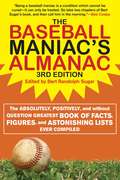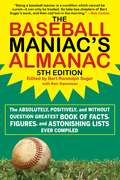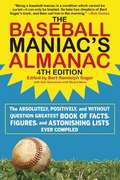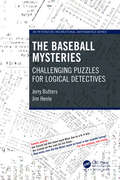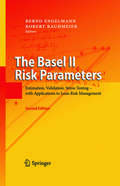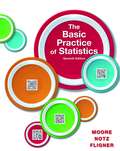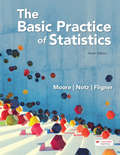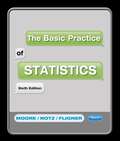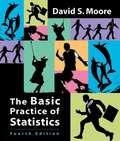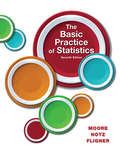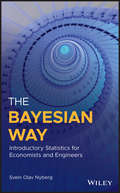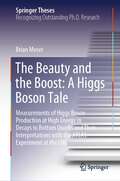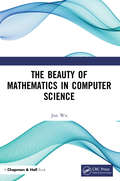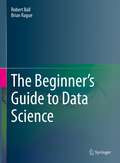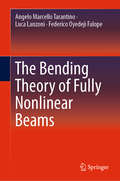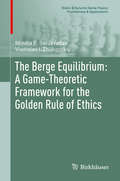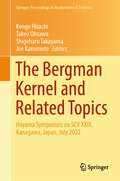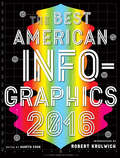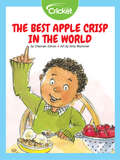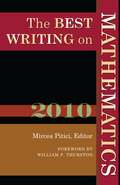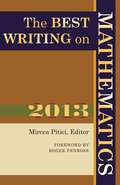- Table View
- List View
The Baseball Maniac's Almanac
by Bert Randolph SugarAn addictive read that is sure to spark conversation wherever baseball is spoken, The Baseball Maniac's Almanac is part reference, part trivia, part brain teaser, and absolutely the greatest, most unusual, and thorough compendium of baseball stats and facts ever compiled-all verified for accuracy by the Baseball Hall of Fame. In its pages, renowned sportswriter Bert Randolph Sugar presents thousands of fascinating lists, tables, data, and stimulating facts about: Individual players and teams Managers Player relatives The Hall of Fame Annual awards The World Series All-Star Games The book also contains a list of the all-time statistical leaders for every major league team as well as a truly unforgettable miscellaneous section that answers such mind-boggling questions as, "Which major-leaguers have palindromic surnames?" and "Which players born under each zodiac sign have hit the most career home runs?"
The Baseball Maniac's Almanac: The Absolutely, Positively, and Without Question Greatest Book of Facts, Figures, and Astonishing Lists Ever Compiled
by Bert Randolph SugarPart reference, part trivia, part brain teaser, and absolutely the most unusual and thorough compendium of baseball stats and facts ever assembled—all verified for accuracy by the Baseball Hall of Fame. First created by legendary sportswriter Bert Randolph Sugar, and now updated, here are thousands of fascinating lists, tables, data, and stimulating facts. Inside, you&’ll find all of the big name baseball heroes like Babe Ruth, Ted Williams, Ernie Banks, Pete Rose, Denny McLain, Ty Cobb, and a lot of information that will be new to even the most devoted fans: Highest batting averages not to win batting titles Home-run leaders by state of birth Players on last-place teams leading the league in RBIs, by season Most triples by position, season Winners of two &“legs&” of triple crown since last winner Oldest pitchers with losing record, leading league in ERA Career pitching leaders under six feet tall Managers replaced wile team was in first place Hall of Famers whose sons played in the majors Players with palindromic surnames And so much more! Not just a collection of facts or records, this is a book of glorious fun that will astound even the most bookish baseball fan. Read up and amaze your friends!
The Baseball Maniac's Almanac: The Absolutely, Positively, and Without Question Greatest Book of Facts, Figures, and Astonishing Lists Ever Compiled (Baseball Maniac's Almanac: Absolutely, Positively And Without Ser.)
by Bert Randolph Sugar Samelson KenAn addictive read that is sure to spark conversation wherever baseball is spoken, this updated edition of The Baseball Maniac’s Almanac is part reference, part trivia, part brain teaser, and absolutely the most unusual and thorough compendium of baseball stats and facts ever assembled—all verified for accuracy by the Baseball Hall of Fame. In its pages, renowned sportswriter Bert Randolph Sugar presents thousands of fascinating lists, tables, data, and stimulating facts. Inside, you’ll find:Highest batting averages not to win batting titlesHome-run leaders by state of birthPlayers on last-place teams leading the league in RBIs, by seasonMost triples by position, seasonWinners of two “legs” of triple crown since last winnerOldest pitchers with losing record, leading league in ERACareer pitching leaders under six feet tallManagers replaced wile team was in first placeHall of Famers whose sons played in the majorsPlayers with palindromic surnamesAnd so much more! Not just a collection of facts or records, this is a book of glorious fun that will astound even the most bookish baseball fan. Read up and amaze your friends!
The Baseball Maniac's Almanac: The Absolutely, Positively, and without Question Greatest Book of Facts, Figures, and Astonishing Lists Ever Compiled (Baseball Maniac's Almanac: Absolutely, Positively And Without Ser.)
by Bert Randolph Sugar Stuart Shea Ken SamelsonAn addictive read that is sure to spark conversation wherever baseball is spoken, this updated edition of The Baseball Maniac’s Almanac is part reference, part trivia, part brain teaser, and absolutely the most unusual and thorough compendium of baseball stats and facts ever assembled-all verified for accuracy by the Baseball Hall of Fame. In its pages, renowned sportswriter Bert Randolph Sugar presents thousands of fascinating lists, tables, data, and stimulating facts. Inside, you’ll find:Highest batting averages not to win batting titlesHome-run leaders by state of birthPlayers on last-place teams leading the league in RBIs, by seasonMost triples by position, seasonWinners of two "legs” of triple crown since last winnerOldest pitchers with losing record, leading league in ERACareer pitching leaders under six feet tallManagers replaced wile team was in first placeHall of Famers whose sons played in the majorsBabe Ruth’s yearly salaryPlayers with palindromic surnamesAnd so much more!Not just a collection of facts or records, this is a book of glorious fun that will astound even the most bookish baseball fan. Read up and amaze your friends!
The Baseball Mysteries: Challenging Puzzles for Logical Detectives (AK Peters/CRC Recreational Mathematics Series)
by Jim Henle Jerry ButtersThe Baseball Mysteries: Challenging Puzzles for Logical Detectives is a book of baseball puzzles, logical baseball puzzles. To jump in, all you need is logic and a casual fan’s knowledge of the game. The puzzles are solved by reasoning from the rules of the game and a few facts.The logic in the puzzles is like legal reasoning. A solution must argue from evidence (the facts) and law (the rules). Unlike legal arguments, however, a solution must reach an unassailable conclusion.There are many puzzle books. But there’s nothing remotely like this book. The puzzles here, while rigorously deductive, are firmly attached to actual events, to struggles that are reported in the papers every day.The puzzles offer a unique and scintillating connection between abstract logic and gritty reality.Actually, this book offers the reader an unlimited number of puzzles. Once you’ve solved a few of the challenges here, every boxscore you see in the papers or online is a new puzzle! It can be anywhere from simple, to complex, to impossible. For anyone who enjoys logical puzzles For anyone interested in legal reasoning For anyone who loves the game of baseball
The Basel II Risk Parameters: Estimation, Validation, Stress Testing - with Applications to Loan Risk Management
by Robert Rauhmeier Bernd EngelmannThe estimation and the validation of the Basel II risk parameters PD (default probability), LGD (loss given fault), and EAD (exposure at default) is an important problem in banking practice. These parameters are used on the one hand as inputs to credit portfolio models and in loan pricing frameworks, on the other to compute regulatory capital according to the new Basel rules. This book covers the state-of-the-art in designing and validating rating systems and default probability estimations. Furthermore, it presents techniques to estimate LGD and EAD and includes a chapter on stress testing of the Basel II risk parameters. The second edition is extended by three chapters explaining how the Basel II risk parameters can be used for building a framework for risk-adjusted pricing and risk management of loans.
The Basic Practice Of Statistics
by David S. Moore William I. Notz Michael A. FlignerDavid Moore's data analysis (conceptual) approach, which revolutionized the introductory statistics textbook, moves students away from formulas and number-crunching, focusing instead on how working statisticians in a variety of fields collect and analyze data, and use the results to tackle real-world problems. The clear, direct way of emphasizing the course's relevance and confronting students' math anxieties is at the heart of the bestselling The Basic Practice of Statistics (BPS). It is also the ideal approach for taking full advantage of the powerful statistical tools and interactive learning features in this new edition's text/media package. Now more than ever, BPS is ready to help students move from reading about statistical practice to practicing statistics themselves. What's in the LaunchPad
The Basic Practice of Statistics
by David S. Moore William I. Notz Michael A. FlignerThe Basic Practice of Statistics guides you through problem solving with its hallmark Four-Step Process guides you to the solution of statistical problems while emphasizing the importance of current, real data and the importance of using statistics to make decisions in the real world. The importance of interpreting data will prepare you for success in any field you pursue in your education or future career.
The Basic Practice of Statistics
by David S. Moore William I. Notz Michael A. Fligner*This textbook has been transcribed in UEB, formatted according to Braille textbook formats, proofread and corrected. <P><P>[This book] is an introduction to statistics for students in two-year and four-year colleges and universities that emphasizes working with data and statistical ideas. It is designed to be accessible to students with limited quantitative background - just" algebra" in the sense of being able to read and use simple equations. The book is usable with almost any level of technology for calculating and graphing - from a simple "two-variables statistics" calculator through a graphing calculator or spreadsheet program through full statistical software. -To the instructor.
The Basic Practice of Statistics, 4th edition
by David S. MooreThis is an introduction to statistics for college and university students that emphasizes balanced content, working with real data, and statistical ideas.
The Basic Practice of Statistics: Test Bank
by David S. Moore William I. Notz Michael A. FlignerDavid Moore's data analysis (conceptual) approach, which revolutionized the introductory statistics textbook, moves students away from formulas and number-crunching, focusing instead on how working statisticians in a variety of fields collect and analyze data, and use the results to tackle real-world problems. The clear, direct way of emphasizing the course's relevance and confronting students' math anxieties is at the heart of the bestselling The Basic Practice of Statistics (BPS). It is also the ideal approach for taking full advantage of the powerful statistical tools and interactive learning features in this new edition's text/media package. Now more than ever, BPS is ready to help students move from reading about statistical practice to practicing statistics themselves. What's in the LaunchPad
The Bayesian Way: Introductory Statistics For Economists And Engineers
by Svein Olav NybergA comprehensive resource that offers an introduction to statistics with a Bayesian angle, for students of professional disciplines like engineering and economics The Bayesian Way offers a basic introduction to statistics that emphasizes the Bayesian approach and is designed for use by those studying professional disciplines like engineering and economics. In addition to the Bayesian approach, the author includes the most common techniques of the frequentist approach. Throughout the text, the author covers statistics from a basic to a professional working level along with a practical understanding of the matter at hand. Filled with helpful illustrations, this comprehensive text explores a wide range of topics, starting with descriptive statistics, set theory, and combinatorics. The text then goes on to review fundamental probability theory and Bayes' theorem. The first part ends in an exposition of stochastic variables, exploring discrete, continuous and mixed probability distributions. In the second part, the book looks at statistical inference. Primarily Bayesian, but with the main frequentist techniques included, it covers conjugate priors through the powerful yet simple method of hyperparameters. It then goes on to topics in hypothesis testing (including utility functions), point and interval estimates (including frequentist confidence intervals), and linear regression. This book: Explains basic statistics concepts in accessible terms and uses an abundance of illustrations to enhance visual understanding Has guides for how to calculate the different probability distributions, functions , and statistical properties, on platforms like popular pocket calculators and Mathematica / Wolfram Alpha Includes example-proofs that enable the reader to follow the reasoning Contains assignments at different levels of difficulty from simply filling out the correct formula to the complex multi-step text assignments Offers information on continuous, discrete and mixed probability distributions, hypothesis testing, credible and confidence intervals, and linear regression Written for undergraduate and graduate students of subjects where Bayesian statistics are applied, including engineering, economics, and related fields, The Bayesian Way: With Applications in Engineering and Economics offers a clear understanding of Bayesian statistics that have real-world applications.
The Beauty and the Boost: Measurements of Higgs Boson Production at High Energy in Decays to Bottom Quarks and Their Interpretations with the ATLAS Experiment at the LHC (Springer Theses)
by Brian MoserPrecision measurements of the Higgs boson’s properties are a powerful tool to look for deviations from the predictions of the Standard Model (SM) of particle physics. The 139/fb of proton-proton collision data which have been collected by the ATLAS experiment during Run 2 of the LHC, offer an opportunity to investigate rare Higgs-boson topologies, which are particularly sensitive to new physics scenarios but experimentally difficult to access. Several such measurements, which target Higgs-boson decays to heavy-flavour quarks, as well as their combinations are presented in this thesis. A novel analysis that measures Higgs-boson production in association with a heavy vector boson V (VH, with V=W,Z) at high energies is presented. Dedicated Higgs-boson reconstruction techniques are applied to reconstruct the highly Lorentz-boosted Higgs-boson decays into pairs of bottom quarks. The measurement is subsequently combined with a VH cross-section measurement at low and intermediate pT(V) to provide a differential cross-section measurement in kinematic fiducial volumes over the largest possible pT(V) range. All cross-section measurements agree with the SM predictions within relative uncertainties that range from 30% to 300%. The results are furthermore interpreted as limits on the parameters of a SM effective field theory. Finally, a combination of measurements of Higgs decays to heavy-flavour quarks is used to experimentally determine that the Higgs-boson coupling to charm quarks is weaker than to bottom quarks, as predicted by the SM. The target audience for the thesis are physicists and physics students, in particular those with a background in high energy physics.
The Beauty of Mathematics in Computer Science
by Jun WuThe Beauty of Mathematics in Computer Science explains the mathematical fundamentals of information technology products and services we use every day, from Google Web Search to GPS Navigation, and from speech recognition to CDMA mobile services. The book was published in Chinese in 2011 and has sold more than 600,000 copies. Readers were surprised to find that many daily-used IT technologies were so tightly tied to mathematical principles. For example, the automatic classification of news articles uses the cosine law taught in high school. The book covers many topics related to computer applications and applied mathematics including: Natural language processing Speech recognition and machine translation Statistical language modeling Quantitive measurement of information Graph theory and web crawler Pagerank for web search Matrix operation and document classification Mathematical background of big data Neural networks and Google’s deep learning Jun Wu was a staff research scientist in Google who invented Google’s Chinese, Japanese, and Korean Web Search Algorithms and was responsible for many Google machine learning projects. He wrote official blogs introducing Google technologies behind its products in very simple languages for Chinese Internet users from 2006-2010. The blogs had more than 2 million followers. Wu received PhD in computer science from Johns Hopkins University and has been working on speech recognition and natural language processing for more than 20 years. He was one of the earliest engineers of Google, managed many products of the company, and was awarded 19 US patents during his 10-year tenure there. Wu became a full-time VC investor and co-founded Amino Capital in Palo Alto in 2014 and is the author of eight books.
The Beginner's Guide to Data Science
by Robert Ball Brian RagueThis book discusses the principles and practical applications of data science, addressing key topics including data wrangling, statistics, machine learning, data visualization, natural language processing and time series analysis. Detailed investigations of techniques used in the implementation of recommendation engines and the proper selection of metrics for distance-based analysis are also covered.Utilizing numerous comprehensive code examples, figures, and tables to help clarify and illuminate essential data science topics, the authors provide an extensive treatment and analysis of real-world questions, focusing especially on the task of determining and assessing answers to these questions as expeditiously and precisely as possible. This book addresses the challenges related to uncovering the actionable insights in “big data,” leveraging database and data collection tools such as web scraping and text identification.This book is organized as 11 chapters, structured as independent treatments of the following crucial data science topics:Data gathering and acquisition techniques including data creationManaging, transforming, and organizing data to ultimately package the information into an accessible format ready for analysisFundamentals of descriptive statistics intended to summarize and aggregate data into a few concise but meaningful measurementsInferential statistics that allow us to infer (or generalize) trends about the larger population based only on the sample portion collected and recordedMetrics that measure some quantity such as distance, similarity, or error and which are especially useful when comparing one or more data observationsRecommendation engines representing a set of algorithms designed to predict (or recommend) a particular product, service, or other item of interest a user or customer wishes to buy or utilize in some mannerMachine learning implementations and associated algorithms, comprising core data science technologies with many practical applications, especially predictive analyticsNatural Language Processing, which expedites the parsing and comprehension of written and spoken language in an effective and accurate mannerTime series analysis, techniques to examine and generate forecasts about the progress and evolution of data over timeData science provides the methodology and tools to accurately interpret an increasing volume of incoming information in order to discern patterns, evaluate trends, and make the right decisions. The results of data science analysis provide real world answers to real world questions. Professionals working on data science and business intelligence projects as well as advanced-level students and researchers focused on data science, computer science, business and mathematics programs will benefit from this book.
The Bending Theory of Fully Nonlinear Beams
by Angelo Marcello Tarantino Luca Lanzoni Federico Oyedeji FalopeThis book presents the bending theory of hyperelastic beams in the context of finite elasticity. The main difficulties in addressing this issue are due to its fully nonlinear framework, which makes no assumptions regarding the size of the deformation and displacement fields. Despite the complexity of its mathematical formulation, the inflexion problem of nonlinear beams is frequently used in practice, and has numerous applications in the industrial, mechanical and civil sectors. Adopting a semi-inverse approach, the book formulates a three-dimensional kinematic model in which the longitudinal bending is accompanied by the transversal deformation of cross-sections. The results provided by the theoretical model are subsequently compared with those of numerical and experimental analyses. The numerical analysis is based on the finite element method (FEM), whereas a test equipment prototype was designed and fabricated for the experimental analysis. The experimental data was acquired using digital image correlation (DIC) instrumentation. These two further analyses serve to confirm the hypotheses underlying the theoretical model. In the book’s closing section, the analysis is generalized to the case of variable bending moment. The governing equations then take the form of a coupled system of three equations in integral form, which can be applied to a very wide class of equilibrium problems for nonlinear beams.
The Berge Equilibrium: A Game-Theoretic Framework for the Golden Rule of Ethics (Static & Dynamic Game Theory: Foundations & Applications)
by Mindia E. Salukvadze Vladislav I. ZhukovskiyThe goal of this book is to elaborate on the main principles of the theory of the Berge equilibrium by answering the following two questions: What are the basic properties of the Berge equilibrium? Does the Berge equilibrium exist, and how can it be calculated? The Golden Rule of ethics, which appears in Christianity, Judaism, Islam, Buddhism, Confucianism and other world religions, states the following: “Behave towards others as you would like them to behave towards you." In any game, each party of conflict seeks to maximize some payoff. Therefore, for each player, the Golden Rule is implemented through the maximization of his/her payoff by all other players, which matches well with the concept of the Berge equilibrium. The approach presented here will be of particular interest to researchers (including undergraduates and graduates) and economists focused on decision-making under complex conflict conditions. The peaceful resolution of conflicts is the cornerstone of the approach: as a matter of fact, the Golden Rule precludes military clashes and violence. In turn, the new approach requires new methods; in particular, the existence problems are reduced to saddle point design for the Germeier convolution of payoff functions, with further transition to mixed strategies in accordance with the standard procedure employed by E. Borel, J. von Neumann, J. Nash, and their followers. Moreover, this new approach has proven to be efficient and fruitful with regard to a range of other important problems in mathematical game theory, which are considered in the Appendix.
The Bergman Kernel and Related Topics: Hayama Symposium on SCV XXIII, Kanagawa, Japan, July 2022 (Springer Proceedings in Mathematics & Statistics #447)
by Takeo Ohsawa Kengo Hirachi Shigeharu Takayama Joe KamimotoThis volume consists of 15 papers contributing to the Hayama Symposium on Complex Analysis in Several Variables XXIII, which was dedicated to the 100th anniversary of the creation of the Bergman kernel. The symposium took place in Hayama and Tokyo in July 2022. Each article is closely related to the Bergman kernel, covering topics in complex analysis, differential geometry, representation theory, PDE, operator theory, and complex algebraic geometry. Specifically, some papers address the L2 extension operators from a newly opened viewpoint after solving Suita's conjecture for the logarithmic capacity. They are also continuations of quantitative solutions to the openness conjecture for the multiplier ideal sheaves. The study involves estimates for the solutions of the d-bar equations, focusing on the existence of compact Levi-flat hypersurfaces in complex manifolds. The collection also reports progress on various topics, including the existence of extremal Kähler metrics on compact manifolds, Lp variants of the Bergman kernel, Wehrl-type inequalities, homogeneous Kähler metrics on bounded homogeneous domains, asymptotics of the Bergman kernels, and harmonic Szegő kernels and operators on the Bergman spaces and Segal-Bargmann spaces. Some of the papers are written in an easily accessible way for beginners. Overall, this collection updates how a basic notion provides strong insights into the internal relationships between independently found phenomena.
The Best American Infographics 2016
by Gareth Cook Robert Krulwich“When it comes to infographics…the best work in this field grabs those eyes, keeps them glued, and the grip is sensual—and often immediate. A good graphic says ‘See what I see!’ and either you do or you don’t. The best ones…pull you right in, and won’t let you go.” —From the introduction by Robert Krulwich The year’s most “awesome” (RedOrbit) infographics reveal aspects of our world in often startling ways—from a haunting graphic mapping the journey of 15,790 slave ships over 315 years, to a yearlong data drawing project on postcards that records and cements a trans-Atlantic friendship. The Best American Infographics 2016 covers the realms of social issues, health, sports, arts and culture, and politics—including crisp visual data on the likely Democratic/Republican leanings of an array of professions (proving that your urologist is far more likely to be a Republican than your pediatrician). Here once again are the most innovative print and electronic infographics—“the full spectrum of the genre—from authoritative to playful” (Scientific American). ROBERT KRULWICH is the cohost of Radiolab and a science correspondent for NPR. He writes, draws, and cartoons at Curiously Krulwich, where he synthesizes scientific concepts into colorful, one-of-a-kind blog posts. He has won several Emmy awards for his work on television, and has been called “the most inventive network reporter in television” by TV Guide.
The Best Apple Crisp in the World
by Charnan SimonJake wants to learn how to make his grandmother’s apple crisp! The only problem is she doesn’t use a recipe. With his uncle’s help, he must figure out the ingredients and measurements.
The Best Bug Parade (MathStart #Level 1)
by Stuart J. MurphyA variety of different bugs compare their relative sizes while going on parade
The Best Writing on Mathematics 2010 (The Best Writing on Mathematics #1)
by Mircea PiticiThis anthology brings together the year's finest writing on mathematics from around the world. Featuring promising new voices alongside some of the foremost names in mathematics, The Best Writing on Mathematics makes available to a wide audience many articles not easily found anywhere else--and you don't need to be a mathematician to enjoy them. These writings offer surprising insights into the nature, meaning, and practice of mathematics today. They delve into the history, philosophy, teaching, and everyday occurrences of math, and take readers behind the scenes of today's hottest mathematical debates. Here readers will discover why Freeman Dyson thinks some mathematicians are birds while others are frogs; why Keith Devlin believes there's more to mathematics than proof; what Nick Paumgarten has to say about the timing patterns of New York City's traffic lights (and why jaywalking is the most mathematically efficient way to cross Sixty-sixth Street); what Samuel Arbesman can tell us about the epidemiology of the undead in zombie flicks; and much, much more. In addition to presenting the year's most memorable writing on mathematics, this must-have anthology also includes a foreword by esteemed mathematician William Thurston and an informative introduction by Mircea Pitici. This book belongs on the shelf of anyone interested in where math has taken us--and where it's headed.
The Best Writing on Mathematics 2011
by Freeman Dyson Mircea PiticiThis anthology brings together the year's finest mathematics writing from around the world. Featuring promising new voices alongside some of the foremost names in the field, The Best Writing on Mathematics 2011 makes available to a wide audience many articles not easily found anywhere else--and you don't need to be a mathematician to enjoy them. These writings offer surprising insights into the nature, meaning, and practice of mathematics today. They delve into the history, philosophy, teaching, and everyday occurrences of math, and take readers behind the scenes of today's hottest mathematical debates. Here Ian Hacking discusses the salient features that distinguish mathematics from other disciplines of the mind; Doris Schattschneider identifies some of the mathematical inspirations of M. C. Escher's art; Jordan Ellenberg describes compressed sensing, a mathematical field that is reshaping the way people use large sets of data; Erica Klarreich reports on the use of algorithms in the job market for doctors; and much, much more. In addition to presenting the year's most memorable writings on mathematics, this must-have anthology includes a foreword by esteemed physicist and mathematician Freeman Dyson. This book belongs on the shelf of anyone interested in where math has taken us--and where it is headed.
The Best Writing on Mathematics 2012 (The Best Writing on Mathematics #3)
by Mircea PiticiThe year's finest writing on mathematics from around the worldThis annual anthology brings together the year's finest mathematics writing from around the world. Featuring promising new voices alongside some of the foremost names in the field, The Best Writing on Mathematics 2012 makes available to a wide audience many articles not easily found anywhere else--and you don't need to be a mathematician to enjoy them. These writings offer surprising insights into the nature, meaning, and practice of mathematics today. They delve into the history, philosophy, teaching, and everyday occurrences of math, and take readers behind the scenes of today's hottest mathematical debates. Here Robert Lang explains mathematical aspects of origami foldings; Terence Tao discusses the frequency and distribution of the prime numbers; Timothy Gowers and Mario Livio ponder whether mathematics is invented or discovered; Brian Hayes describes what is special about a ball in five dimensions; Mark Colyvan glosses on the mathematics of dating; and much, much more.In addition to presenting the year's most memorable writings on mathematics, this must-have anthology includes a foreword by esteemed mathematician David Mumford and an introduction by the editor Mircea Pitici. This book belongs on the shelf of anyone interested in where math has taken us--and where it is headed.
The Best Writing on Mathematics 2013 (The Best Writing on Mathematics #4)
by Mircea PiticiThe year's finest writing on mathematics from around the world, with a foreword by Nobel Prize–winning physicist Roger PenroseThis annual anthology brings together the year's finest mathematics writing from around the world. Featuring promising new voices alongside some of the foremost names in the field, The Best Writing on Mathematics 2013 makes available to a wide audience many articles not easily found anywhere else—and you don't need to be a mathematician to enjoy them. These writings offer surprising insights into the nature, meaning, and practice of mathematics today. They delve into the history, philosophy, teaching, and everyday occurrences of math, and take readers behind the scenes of today's hottest mathematical debates. Here Philip Davis offers a panoramic view of mathematics in contemporary society; Terence Tao discusses aspects of universal mathematical laws in complex systems; Ian Stewart explains how in mathematics everything arises out of nothing; Erin Maloney and Sian Beilock consider the mathematical anxiety experienced by many students and suggest effective remedies; Elie Ayache argues that exchange prices reached in open market transactions transcend the common notion of probability; and much, much more.In addition to presenting the year's most memorable writings on mathematics, this must-have anthology includes a foreword by esteemed mathematical physicist Roger Penrose and an introduction by the editor, Mircea Pitici. This book belongs on the shelf of anyone interested in where math has taken us—and where it is headed.
